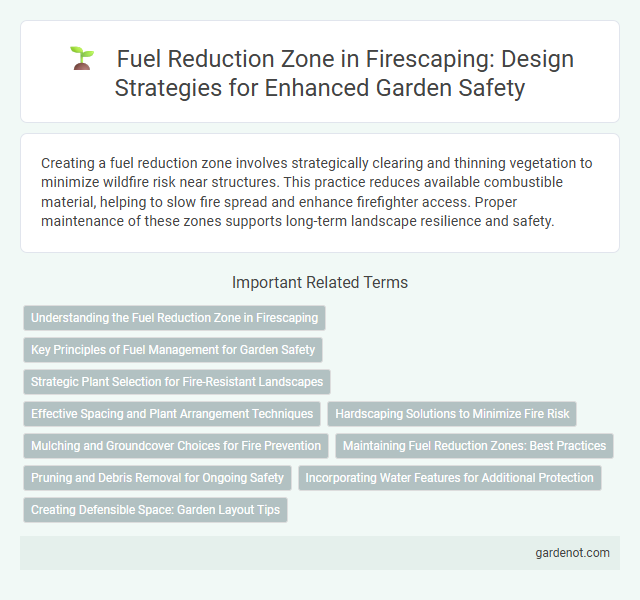Creating a fuel reduction zone involves strategically clearing and thinning vegetation to minimize wildfire risk near structures. This practice reduces available combustible material, helping to slow fire spread and enhance firefighter access. Proper maintenance of these zones supports long-term landscape resilience and safety.
Understanding the Fuel Reduction Zone in Firescaping
A fuel reduction zone in firescaping is a designated area where vegetation and combustible materials are strategically minimized to slow the spread of wildfires. This zone typically extends 30 to 100 feet around structures, reducing the available fuel load to create a defensible space for fire suppression efforts. Effective management of shrubs, dead plants, dry leaves, and other flammable debris within this zone significantly decreases the risk of property damage during wildfires.
Key Principles of Fuel Management for Garden Safety
Effective fuel reduction zones in firescaping emphasize removing dead vegetation, pruning low-hanging branches, and maintaining adequate spacing between plants to minimize fire spread. Regularly clearing dry leaves, mulch, and debris near structures reduces combustible material that could ignite easily. Selecting fire-resistant plants and ensuring consistent irrigation further enhance garden safety by limiting available fuels and improving moisture levels.
Strategic Plant Selection for Fire-Resistant Landscapes
Strategic plant selection within a fuel reduction zone is crucial to creating fire-resistant landscapes by choosing species with low flammability and high moisture content. Incorporating drought-tolerant, deciduous, and fire-resistant plants such as succulents, native grasses, and hardwoods reduces available fuel and slows fire spread. Proper spacing and maintenance of these plants further enhance the landscape's resilience against wildfire threats.
Effective Spacing and Plant Arrangement Techniques
Effective spacing and plant arrangement techniques in a Fuel Reduction Zone minimize wildfire intensity by interrupting the fuel continuity and reducing ladder fuels. Strategically placing plants with varying heights and maintaining appropriate distances between them limits fire spread and provides defensible space around structures. Incorporating fire-resistant species and avoiding dense clustering further enhances the zone's protective function against wildfires.
Hardscaping Solutions to Minimize Fire Risk
Hardscaping solutions such as gravel beds, stone pathways, and concrete patios create effective fuel reduction zones by eliminating combustible vegetation close to structures. Incorporating non-flammable materials in landscape design reduces wildfire ignition potential and slows fire spread. Strategic placement of hardscape elements acts as physical barriers, enhancing property defensibility in fire-prone areas.
Mulching and Groundcover Choices for Fire Prevention
Mulching with fire-resistant materials such as gravel, stone, or decomposed granite helps create effective fuel reduction zones by minimizing combustible organic matter. Selecting low-flammability groundcovers like succulents, ice plant, or native drought-tolerant species reduces fire spread risk while conserving soil moisture. Proper maintenance, including regular debris removal and maintaining clear spaces around plants, enhances the protective benefits of these strategic landscaping choices.
Maintaining Fuel Reduction Zones: Best Practices
Maintaining fuel reduction zones involves regularly removing dead vegetation, trimming shrubs, and mowing grasses to minimize wildfire risk and ensure effective firebreaks. Emphasize proper disposal of debris to prevent accumulation and avoid reintroducing flammable materials. Consistent monitoring and seasonal maintenance support long-term resilience and reduce the intensity of potential wildfires.
Pruning and Debris Removal for Ongoing Safety
Maintaining a fuel reduction zone through regular pruning and debris removal is critical for ongoing fire safety by minimizing available combustible materials around structures. Pruning dead branches, thinning dense vegetation, and clearing fallen leaves and twigs reduce fire intensity and slow its spread. Consistent management of plant growth in these zones enhances defensible space and protects against wildfire damage.
Incorporating Water Features for Additional Protection
Fuel reduction zones in firescaping can be enhanced by strategically incorporating water features such as ponds, fountains, or streambeds, which act as natural firebreaks by maintaining increased moisture levels around properties. These water features not only reduce the availability of combustible materials but also create humidity zones that slow down fire spread. Proper integration of water elements with drought-resistant, low-flammability plants maximizes fire protection and supports sustainable landscaping.
Creating Defensible Space: Garden Layout Tips
Establish a Fuel Reduction Zone by strategically spacing plants with low flammability and incorporating non-combustible materials such as gravel or stone pathways to create defensible space around your garden. Maintain a vertical and horizontal separation between vegetation layers to prevent fire laddering, focusing on removing dead plants, dry leaves, and excess mulch that serve as fuel. Prioritize drought-resistant, fire-resistant plant species and ensure regular pruning to reduce combustible biomass and enhance firebreak effectiveness.
Fuel reduction zone Infographic

 gardenot.com
gardenot.com